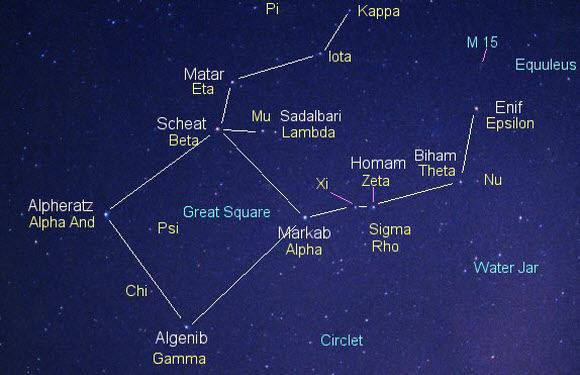Having shown how the familiar star pattern of the Plough may be used to locate other constellations in the north and west part of the sky, another highly useful arrangement of stars currently visible in the autumn sky may be utilised to pick out aspects of the South and East.

Labeled chart of the Pegasus (Image courtesy Illinois University)
This arrangement, known as the ‘Square of Pegasus’ – part of the constellation of Pegasus itself, is located quite high in the South-East during the evening. The stellar members of this large asterism are not particularly conspicuous, but appear so due to the lack of other stars within this region. Located at the top left hand corner of the square is Alpheratz, which is actually the chief star of Andromeda. Remember we can use this star as the jumping off point to find the Andromeda galaxy. Travelling clockwise around the ‘square’, we encounter the stars; Scheat, Markab and Algenib. By following a line diagonally through Alpheratz and Markab (alpha Pegasi), and continuing on down to the SE you are first guided to a zig-zag arrangement of stars representing the water jar, part of the zodiac constellation of Aquarius, the Water Bearer. Continue on this same trajectory and you will locate Capricornus - the Sea Goat, just above the SSW horizon.
Return back to the ‘square’, and by sighting down through the rear two stars; Scheat and Markab, you will eventually drop upon on a conspicuous star just above the SSE horizon - Fomalhaut. This star marks the mouth of Pisces Austrinus - the Southern Fish, a constellation that barely rises from our latitude. Fomalhaut is thus the most southerly of first magnitude stars (those ranked brightest) visible from Britain. The constellation’s northern counterpart – Pisces, occupies a large portion of the sky below Pegasus. A faint circlet of stars directly below the square represents Aphrodite the western fish; whilst the eastern fish, Heros, lies below Andromeda. A ribbon of faint stars joins the two.
The largest sea creature in the heavens - Cetus, the Whale - may be hunted down by using Alpheratz and Algenib as pointers. They point down toward its brightest star, Deneb Kaitos or Diphda, which marks the great tail of the creature. The head, another irregular loop of faint stars (apart from Alpha Ceti -Menkar) lies below Aries.
The most celebrated object in Cetus is a variable star called Mira “the wonderful”, an extraordinary pulsating red super giant perhaps 300 million km (200m miles) in diameter. At maximum, which Mira is in November, it is visible to the naked eye, but when at minimum seven months later even binoculars struggle to pick it out. Mira lies roughly midway between Menkar and Diphda. See if you can spot it in binoculars.
- Log in to post comments
